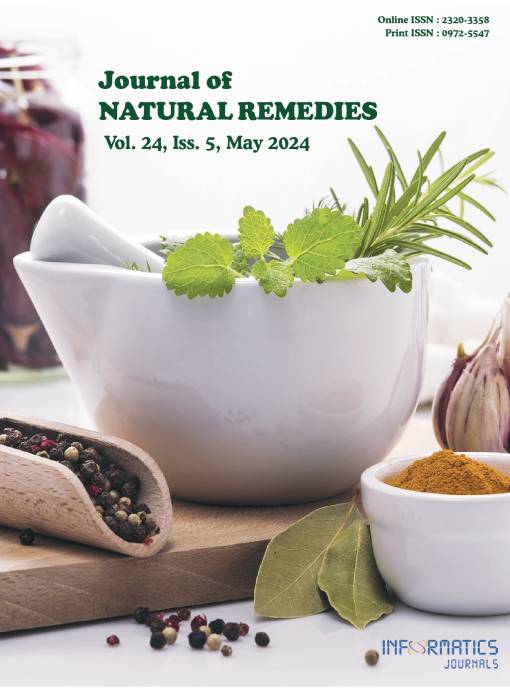Evaluation of Hibiscus sabdariffa Aerial Parts against Pyloric Ligation-induced Ulcers in Experimental Rats
DOI:
https://doi.org/10.18311/jnr/2024/35163Keywords:
Anti-ulcer Activity, Hibiscus sabdariffa, Lansoprazole, Pylorus Ligation, Ulcer IndexAbstract
The sloughing off inflammatory dead tissue is characteristic of ulcers, which are open sores of the skin or mucous membrane. Peptic ulcers are erosive lesions on the stomach or duodenal lining. The drive of the study was to evaluate the effectiveness of Hibiscus sabdariffa aerial parts extracts against pylorus ligation-induced ulcers. The extracts were prepared by maceration using ethanol and double distilled water. In the treatment schedule, Groups A and B were considered negative and standard (Lansoprazole 8 mg/kg b. wt, p.o.) controls. Groups C, D, E, and F as low (200 mg/kg b. wt, p.o.) and high (400 mg/kg b. wt, p.o.) dose treatment groups, received EEHS and AEHS, respectively. Gastric content, pH, free and total acidity, ulcer index, and inhibition of ulcer (%) were assessed. Following administration of both extracts, measurements of stomach content, free and total acidity, and ulcer index decreased. Additionally, pH increased, and a greater percentage of ulcers were inhibited. It was discovered that the ethanolic extract had significantly higher anti-ulcer action than the aqueous extract.
Downloads
Metrics
Downloads
Published
How to Cite
Issue
Section
License
Copyright (c) 2024 V. V. Rajesham, Mitta Raghavendra, G. Supriya Reddy, P. Roshan Ali, T. Rama Rao (Author)

This work is licensed under a Creative Commons Attribution 4.0 International License.
Accepted 2024-03-15
Published 2024-05-01
References
Jain P. Secondary metabolites for antiulcer activity. Nat Prod Res. 2016; 30(6):640-56. https://doi.org/10.1080/14786419.2015.1036269 PMid:25920371
Appavoo K, Ram M, and Rao RK. Treatment of peptic ulcers with a Siddha medicine, "Sirucinni Uppu" and prediction with regression models. Inform Med Unlocked. 2019; 15:1-4. https://doi.org/10.1016/j.imu.2019.100169
Najm WI. Peptic ulcer disease. Prim Care Clin Off Pract. 2011; 38(3):383-94. https://doi.org/10.1016/j.pop.2011.05.001 PMid:21872087
Napolitano L. Refractory peptic ulcer disease. Gastroenterol Clin North Am. 2009; 38(2):267-88. https://doi.org/10.1016/j.gtc.2009.03.011 PMid:19446258
Kempenich JW, Sirinek KR. Acid peptic disease. Surg Clin North Am. 2018; 98(5):933-44. https://doi.org/10.1016/j.suc.2018.06.003 PMid:30243454
Lim WY, Subramaniam M, Abdin E, Vaingankar J, Chong SA. Peptic ulcer disease and mental illnesses. Gen Hosp Psychiatry. 2014; 36(1):63-7. https://doi.org/10.1016/j.genhosppsych.2013.09.004 PMid:24120385
Urs AN, Narula P, Thomson M. Peptic ulcer disease. Paediatrics and Child Health. 2014; 24(11):485-90. https://doi.org/10.1016/j.paed.2014.06.003
Awaad AS, El-Meligy RM, Soliman GA. Natural products in the treatment of ulcerative colitis and peptic ulcer. J Saudi Chem Soc. 2013; 17(1):101-24. https://doi.org/10.1016/j.jscs.2012.03.002
Jain P, Satapathy T, Pandey RK. Rhipicephalus microplus (acari: Ixodidae): Clinical safety and potential control by topical application of cottonseed oil (Gossypium sp.) on cattle. Exp Parasitol. 2020; 219:108017. https://doi.org/10.1016/j.exppara.2020.108017 PMid:33039477
Jain P, Satapathy T, Pandey RK. Efficacy of arecoline hydrobromide against cattle tick Rhipicephalus (Boophilus) microplus. Int J Acarol. 2020; 46(4):268-75. https://doi.org/10.1080/01647954.2020.1765018
Sharwan G, Jain P, Pandey R, Shukla SS. Toxicity and safety profiles of methanolic extract of Pistacia integerrima JL Stewart ex Brandis (PI) for Wistar Rats. J Pharmacopunct. 2016; 19(3):253. https://doi.org/10.3831/KPI.2016.19.027 PMid:27695635 PMCid: PMC5043090
Jain P, Rao SP, Singh V, Pandey R, Shukla SS. Acute and sub-acute toxicity studies of an ancient ayurvedic formulation: Agnimukha Churna. Columbia J Pharmaceutical Sci. 2014; 1:18-22.
Zinatloo-Ajabshir Z, Zinatloo-Ajabshir S. Preparation and characterization of curcumin niosomal nanoparticles via a simple and eco-friendly route. J Nanostruct. 2019; 9(4):784-90.
Da-Costa-Rocha I, Bonnlaender B, Sievers H, Pischel I, Heinrich M. Hibiscus sabdariffa L.–A phytochemical and pharmacological review. Food Chem. 2014; 165:424-43. https://doi.org/10.1016/j.foodchem.2014.05.002 PMid:25038696
Uku UP, Fokunang TE, Grace M, Borgia NN, Mogue I, Bathelemy N, Nchafor NV, Fonmboh JD, Nyuki AB, Yves TO, Marcel NE. Phytochemical screening and antiulcer activity, of Ficus thonningii (Moraceae) aqueous fruits extract in Wistar rats. Asian J Res Med Pharm Sci. 2020; 9(1):41-59. https://doi.org/10.9734/ajrimps/2020/v9i130145
Shay Komarov SA, Fels SS, Meranze D, Gruenstein M, Siplet H. A simple method for the uniform production of gastric ulceration. Gastroenterol. 1945; 5:43-55.
Gadekar R, Singour PK, Chaurasiya PK, Pawar RS, Patil UK. A potential of some medicinal plants as antiulcer agents. Pharmacogy Rev. 2010; 4(8):136. https://doi.org/10.4103/0973-7847.70906 PMid:22228953 PMCid: PMC3249913
Vimala G, Gricilda Shoba F. A review on antiulcer activity of few Indian medicinal plants. Int J Microbiol. 2014. https://doi.org/10.1155/2014/519590 PMid:24971094 PMCid: PMC4058214
Sachin SS, Archana J. Antiulcer activity of methanol extract of Erythrina indica Lam. leaves in experimental animals. Pharmacogn Res. 2009; 1(6):396-401.
de Lira Mota KS, Dias GE, Pinto ME, Luiz-Ferreira A, Monteiro Souza-Brito AR, Hiruma-Lima CA, Barbosa-Filho JM, Batista LM. Flavonoids with gastroprotective activity. Molecules. 2009; 14(3):979-1012. https://doi. org/10.3390/molecules14030979 PMid:19305355 PMCid: PMC6253827
Sumbul S, Ahmad MA, Mohd A, Mohd A. Role of phenolic compounds in peptic ulcer: An overview. J Phar Bioallied Sci. 2011; 3(3):361-7. https://doi.org/10.4103/0975-7406.84437 PMid:21966156 PMCid: PMC3178942
Martha LK, Thummuru ES, Vemishetty V, Sai Sruthi Perabattula, S, Sagi AK. Comparative review on anti-ulcer activity of some medicinal plant extracts. Int J Pharm Sci Res. 2023; 14(1):50-5.
Kahraman A, Erkasap N, Köken T, Serteser M, Aktepe F, Erkasap S. The antioxidative and antihistaminic properties of quercetin in ethanol-induced gastric lesions. Toxicol. 2003; 183(1-3):133-42. https://doi.org/10.1016/S0300-483X(02)00514-0 PMid:12504347
Ahmed O, Nedi T, Yimer EM. Evaluation of anti-gastric ulcer activity of aqueous and 80% methanol leaf extracts of Urtica simensis in rats. Metabolism Open. 2022; 14:100172. https://doi.org/10.1016/j.metop.2022.100172 PMid:35313530 PMCid: PMC8933831

 V. V. Rajesham
V. V. Rajesham









 0.35
0.35 24
24 0.161
0.161